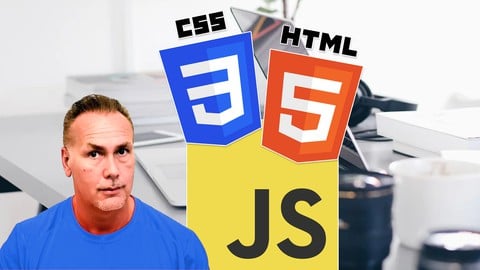
Price: $64.99
Web Design for Beginners Modern HTML CSS JavaScript coding
Learn how to
-
How to create web pages with HTML and CSS
-
Create interactive web content with JavaScript
-
Basics of coding JavaScript
-
Bring your web pages to life with Code
-
Modern Responsive WebSites
-
Interactive and Dynamic Web Pages
Are you curious about creating websites, this course is the perfect place to start.
Enroll now to get instant access to:
-
9+ hours of premium lessons
-
16 page downloadable workbook HTML source code, tips, resources and challenges
-
32 page downloadable workbook CSS includes source code, tips, resources and challenges
-
10 + 17 page downloadable workbooks JavaScript includes source code, tips, resources and challenges
-
Premium instructor support to help you learn
-
Lifetime access to course updates
Learn all the core fundamentals of modern web design, covering all the commonly used syntax for HTML and CSS. This course is designed to get you started quickly and easily with creating web pages.
Course covers all the essentials so that you can begin quickly on your journey to create amazing looking websites. Add JavaScript to make your web pages come to life.
Covering the core concepts of JavaScript so that you can try the code and get familiar with what it does. Using JavaScript you can access the HTML DOM in the browser which allows you to interact and manipulate web page content. JavaScript creates the interactive and dynamic content seen today in all major modern web pages.
Explore how you can start coding quickly and focus on designing your webpages, loaded with source code and examples.
Each section comes with a PDF guide that includes useful section resources, and source code from the lessons so that you can try the code for yourself.
Learn HTML – how to create an HTML file and structure your HTML code in a modern format ready to be styled. Lessons of this section cover how to get started with coding and creating web pages.
Setup your Editor and create HTML files
Debug your code
HTML tags for page structure
What makes up an HTML element
What are Self closing Tags
How to use Element Attributes
Linking pages together with Hyperlinks
Adding Images to your web page
Lists and Tables for readable content
Semantic Page elements
How to create a simple webpage
Go live with a Github page and your HTML site
Learning HTML covers the following code.
-
Editor and setup to write HTML – create an html file
-
Anatomy of an HTML element – opening tag, content, element, closing tag
-
4 must add tags for HTML pages html, head, title, body
-
Comments in Code
-
Create a basic template
-
Introduction to common HTML tags
-
Self closing tags
-
Tag attributes (id, style, class)
-
anchor tag hyperlinks connecting pages
-
add images- self closing tags
-
Lists
-
-
tables
HTML semantic elements
Learn CSS
What CSS is and how you can style your web pages with Cascading Style Sheets. HTML provides structure for your webpage, CSS allows you to style your page. Design the page with your style, setup page layouts, add colors, fonts, and more. Present your web pages as you want them to look, independent of the HTML you can make your web content look and style as you imagine it should.
Explore how to add CSS to your HTML page
How to add colors to page element backgrounds and text
What the box model is and how you can apply borders, margins, and padding to any page element.
Style the text, update the font and customize your text output.
Update you links, adding Pseudo classes to your page elements
How to apply display properties, position and floats to set up your page layout.
Really useful CSS properties explored
CSS combinators for selection of elements.
How to build a responsive webpage with CSS float, CSS grid and CSS flexbox.
Use CSS Cascading Style Sheets common syntax covered in this section.
-
Google Chrome Dev Tools
-
Adding Styling to HTML tags style
-
